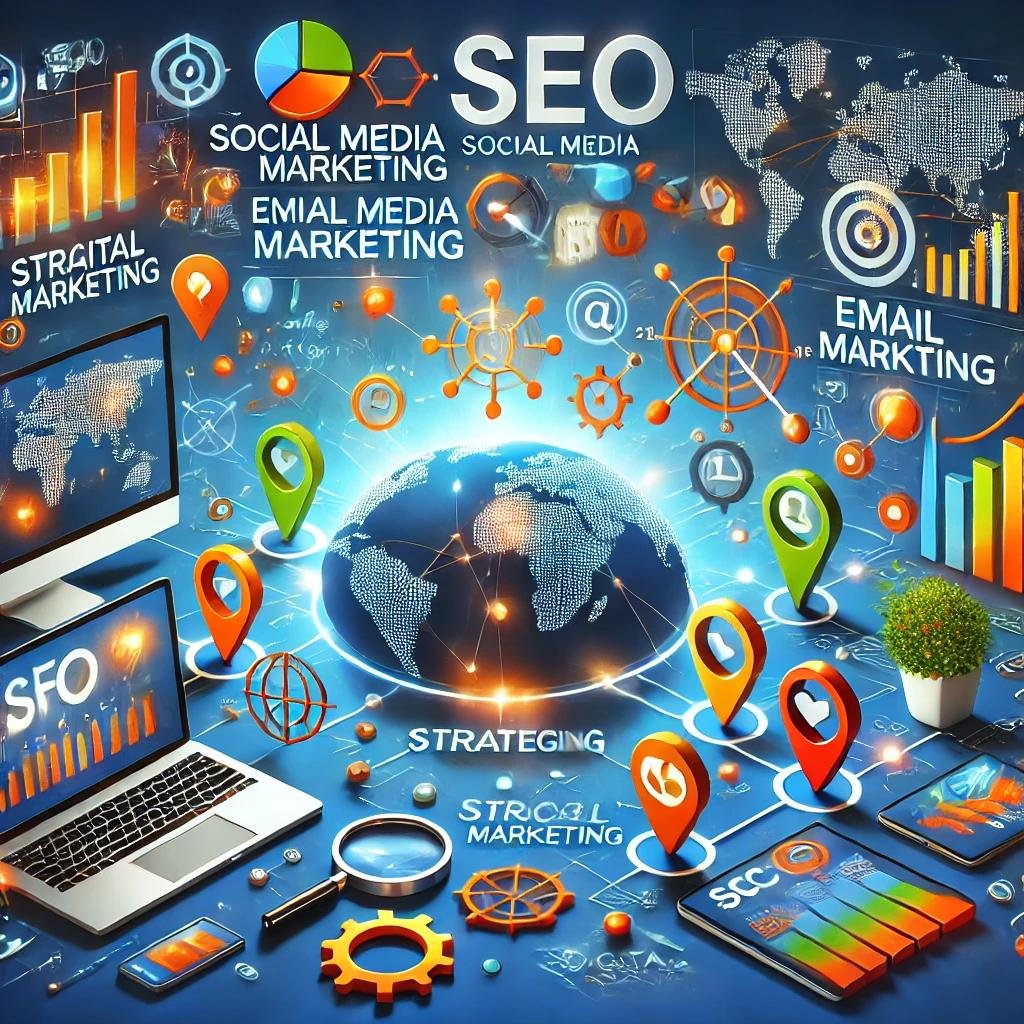Unlock the full potential of digital marketing with this comprehensive guide. Learn about SEO, PPC, social media, and more to drive growth and engagement online.”
Introduction: What is Digital Marketing?
In today’s digital age, businesses are increasingly relying on digital marketing to connect with their target audience. But what exactly is digital marketing? It refers to the use of digital channels such as search engines, social media, email, and mobile apps to promote products and services. Unlike traditional marketing, which relies on TV, print, and radio, digital marketing allows for real-time interaction and personalization with customers.
The real power of digital marketing lies in its ability to track campaign performance, providing insights into what’s working and what needs improvement. As internet usage continues to grow globally, digital marketing has become a vital component of any successful business strategy.
The significance of digital marketing in today’s business world is undeniable.
With over 4.6 billion internet users worldwide, digital marketing is more critical than ever. Businesses that invest in digital strategies are seeing substantial growth in brand awareness and revenue. According to Statista, global digital ad spend is expected to surpass $500 billion by 2024, highlighting its importance in modern marketing.
Digital marketing stands out for its ability to target audiences with precision. Tools like Google Ads and Facebook Ads allow businesses to reach potential customers based on their search behavior, interests, and demographics. Additionally, real-time analytics enable businesses to track campaign performance and make quick adjustments, optimizing both time and cost.
10 Key Types of Digital Marketing: Explained with Real-World Examples
1.Search Engine Optimization (SEO) – Increase Organic Traffic
SEO is the process of optimizing your website to rank higher in search engines like Google. This involves targeting specific keywords that users are searching for and improving your website’s content, structure, and backlinks.
Real-World Example:
Moz, a leader in SEO tools, ranks high for competitive keywords such as “SEO guide” and “keyword research.” Their well-structured blogs and resources drive consistent organic traffic.
Why It Works:
Most users prefer websites that appear on the first page of search results. In reality, 75% of users don’t go beyond the first page when scrolling through search results.
2. Pay-Per-Click (PPC) Advertising – Achieve Immediate Visibility
PPC is a paid form of advertising where businesses pay a fee each time their ad is clicked. Ads can be displayed on search engines, social media platforms, and websites.
Real-World Example:
Google Ads is a popular PPC platform. For instance, a shoe retailer can bid on the keyword “buy running shoes” to appear at the top of Google search results and only pay when a user clicks on the ad.
Why It Works:
PPC offers immediate exposure and can drive traffic to your website quickly, making it an excellent strategy for businesses seeking fast results.
3. Content Marketing – Engage and Educate Your Audience
Content marketing involves creating valuable, informative content to attract and engage your audience. This may consist of blogs, videos, eBooks, infographics, and various other types of content.
Real-World Example:
HubSpot excels in content marketing by offering free resources like blogs, eBooks, and webinars that attract and convert visitors into leads.
Why It Works:
Content marketing generates three times more leads than traditional outbound marketing, and it helps establish your brand as an industry authority.
4. Social Media Marketing – Build Relationships and Brand Loyalty
Social media marketing uses platforms like Facebook, Instagram, LinkedIn, and Twitter to engage with audiences, promote products, and build brand loyalty.
Real-World Example:
Nike’s social media campaign #JustDoIt encourages people to share personal stories of overcoming challenges, creating an emotional connection with the brand.
Why It Works:
Social media allows for direct engagement with users, fostering relationships and increasing brand loyalty.
5. Email Marketing – Personalized Engagement with High ROI
Email marketing involves sending personalized, targeted messages to your audience. It’s one of the most effective ways to nurture leads and convert them into customers.
Real-World Example:
Amazon sends personalized product recommendations based on users’ browsing and purchasing history, driving repeat sales and keeping users engaged.
Why It Works:
For every $1 spent on email marketing, businesses see an average return of $42, making it one of the most cost-effective marketing strategies.
6. Affiliate Marketing – A Performance-Based Strategy
Affiliate marketing is a system where businesses pay commissions to affiliates (partners) who promote their products. Affiliates earn when a customer purchases through their referral links.
Real-World Example:
Bluehost offers a successful affiliate marketing program where bloggers earn commissions by promoting Bluehost’s services on their websites.
Why It Works:
Affiliate marketing is low-risk and results-driven, as businesses only pay for successful referrals.
7. Influencer Marketing – Harness the Power of Social Proof
Influencer marketing involves collaborating with influencers—individuals with large followings on social media platforms—to promote your products or services.
Real-World Example:
Fashion Nova built its brand by partnering with Instagram influencers to showcase its clothing line, directly reaching millions of potential customers.
Why It Works:
Influencers can build trust with niche audiences, making this strategy highly effective for brands looking to target specific markets.
8. Mobile Marketing – Reach Customers on Their Smartphones
Mobile marketing focuses on reaching users through mobile devices via SMS, mobile ads, or app notifications. With mobile traffic accounting for over 50% of global web usage, this is a crucial tactic.
Real-World Example:
Starbucks uses its mobile app to send personalized offers and location-based notifications, driving both foot traffic and app engagement.
Why It Works:
Mobile marketing meets consumers where they are—on their smartphones, providing a convenient way to engage with them.
9. Native Advertising – Seamless, Non-Intrusive Ads
Native advertising places paid content that blends seamlessly with the platform it appears on, making it less disruptive to the user experience.
Real-World Example:
BuzzFeed often publishes sponsored listicles that subtly promote products within content that resembles their usual style.
Why It Works:
Native ads are less intrusive than traditional ads, which makes users more likely to engage with the content.
10. Online PR (Public Relations) – Build a Positive Online Reputation
Online PR focuses on improving a company’s reputation through press releases, media outreach, and online publications.
Real-World Example:
Coca-Cola uses online PR to highlight its sustainability initiatives, building a positive brand image.
Why It Works:
Online PR helps companies manage their reputation, particularly in today’s age of social media where negative information spreads quickly.
Benefits and Drawbacks of Digital Marketing
Benefits:
- Global Reach: Digital marketing breaks geographical barriers, allowing you to reach a worldwide audience.
- Targeted Advertising: It offers precise targeting based on demographics, behaviors, and interests.
- Cost-Effective: It’s more affordable than traditional marketing and provides a higher ROI.
- Measurable Results: You can track performance in real-time and adjust strategies accordingly.
Drawbacks:
- High Competition: The digital landscape is crowded, making it difficult to stand out without a strong strategy.
- Changing Algorithms: The algorithms of search engines and social platforms are constantly evolving, impacting visibility.
- Data Privacy: As regulations on data privacy tighten, businesses must be careful about how they collect and use customer information.
The Future of Digital Marketing
As new technologies continue to emerge, digital marketing will evolve. Artificial intelligence (AI) and machine learning are already being used to personalize user experiences, while voice search and video marketing are growing trends that businesses should embrace.
To stay competitive, brands must adapt to these trends and continue to innovate their digital strategies.
FAQs
- Why is digital marketing important for businesses?
Digital marketing allows businesses to reach a global audience, engage with customers in real-time, and optimize campaigns based on data-driven insights. - What is the significance of SEO in digital marketing?
SEO helps websites rank higher in search engines, increasing organic traffic and boosting credibility. - How does social media marketing work?
Social media marketing involves promoting a brand through platforms like Facebook and Instagram to engage with users and drive sales. - What is PPC advertising?
PPC is a paid advertising model where businesses pay for their ads to appear in search results or social media feeds based on clicks.


2 Comments
Pingback: The Four Stages of Marketing Evolution – Dreambiggertoday
Pingback: "Best Search Engines of 2024: Find Your Perfect Search Platform!" - Dreambiggertoday